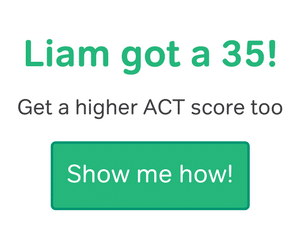Being an ACT tutor is a rewarding experience. But before you start imparting your wisdom to others, you need to know the ins and outs of tutoring. In this post, we’ll take a look at the exam through a new lens: the ACT for tutors.

Here at Magoosh, we’ve worked with thousands of students on improving their ACT scores. Whether you’re just starting your work as a tutor or have been tutoring for a long time now, we hope you’ll find some new tips and strategies to help your students (and yourself) strive for excellence!
Getting to Know Your Students
Every student you tutor will have the same goal—improve their ACT scores— but have completely different roadblocks between them and success. That is why, when you meet your students for the first time, get to know them as individuals rather than just test takers. Learning a little about the person can say a lot about what he or she needs to succeed on the ACT. For example, let’s look at case studies two very different types of students, and how you might approach each on your first meeting.

The first type of student is one who would rather be anywhere else than sitting with you. Most likely they don’t care about the ACT, and are only there because their parents made them. Though they might seem antagonistic, conversing with them about their interests and what they might want to do after high school can give you an opening to discuss the importance of the ACT. Also, research if your state has a lottery scholarship awarded based on ACT scores. The prospect of a little money can go a long way in getting teenagers on board with studying.
Another type of student is the overachiever. Though usually good-natured, the pressure to perform well may have led this student to a cycle of stress and disappointment when it comes to high-stakes tests. For these students, a discussion about study planning and college applications can put some of their worries to rest, while showing them that they have some control over the process. High school juniors already have enough on their plate, so giving them help (or even telling a story about yourself) can reduce their stress and build rapport.
Differentiation
Once you get to know your students as people, it’s time to get to know them as students. Before your first tutoring session, it’s always a good idea to ask the parents a few questions. Do they do well in school? Do they struggle in any particular subject(s)?
Even if you receive some information from the parents, always ask the students about themselves, too. It makes them feel more invested in the process, and that you actually care about their situation and future. Beyond that, it may give you a completely different perspective on their learning styles than parental information did. Always take the time to do this.
The key to differentiation amongst students is scaffolding. Unlike the scaffolds around buildings under construction, an academic scaffold is the level of support you give to a student throughout the lesson. Some students, when they learn a new concept, have very little trouble applying it to practice problems. Others will struggle more, and this is when more scaffolding can help.
Scaffolding doesn’t mean doing the problems for them, but rather offering the right amount of guidance. Though some trial and error will be necessary to determine how much scaffolding each student requires, the right level of support goes a long way to helping students progress and internalize concepts you’ve covered together.
Tracking Progress
Whether you have one student or twenty, tracking progress is an important step in both your success as a teacher and your students’ success on the ACT. Your students, like all people completing a task, want to see that their efforts are having a positive effect. This can be especially tough when some processes, such as test prep, can take some time to show appreciable affects, and learning new techniques can initially cause a dip in scores (before they shoot up, of course!)
Having student graph their own progress can ease some of this student worry. Before teaching a concept, have students answer roughly twenty questions that focused on that concept. Have them record their scores (you should keep track of them as well). After teaching concept and students have practiced it, they’ll then answer a new set of twenty questions. It’s important to note that there are usually a handful of students who still struggle with this second set. With these students, make sure to go back and give those students a greater amount of scaffolding during the next session.
Make it Engaging
As we all know, teenagers can be some of the most cynical people on the planet. Try to do something nice for them and half the time, the best you can hope for is an eye roll. Nevertheless, as a tutor, your job depends just as much on engaging your audience as knowing the content and strategies to conquer the ACT. It’s not just about making the material fun, but also about making it relevant to students’ plans for the future.
It’s a little intimidating, especially if you’re new to tutoring, but it’s true: you really only have one shot to make the material relevant before the students either tune in or out what you’re trying to teach them. The first few minutes of the lesson are the most important, the hook you use to catch students’ attention.
Let’s say, for example, that you’ve prepared a lesson on charts and graphs on the ACT Science Test. As most students struggle with this part of the ACT, you know their frustration with the subject will cause many of them to tune out really quickly.
You can’t throw students into the deep end right away, and you want to connect the lesson to their lives. Therefore, you begin the lesson by having students analyze the charts and graphs they see in their daily lives, or some that they may encounter as adults. A perfect example is a nutrition label. Asking students some basic questions about the chart/graph they’ve already seen will activate prior knowledge. Not only will students see the relevance of the lesson, but the hook activity will prime their brains for the new concepts you will teach. Consider it the mental equivalent of stretching before a run.
But Remember…
At the end of the day, you are these students’ instructor. If you’ve never worked with adolescents before, here are a few tips:
- Be friendly, but not their friend. Don’t get involved in unnecessary discussions about their friendships, family, or other inappropriate topics.
- Reserve praise for when it is due. Students need to know that when you do praise them, you mean it. (The flip side of this is to make sure to offer praise when they have!)
- Every tutoring session is a new opportunity to reach out to a student.
Final Thoughts
Being a tutor is a big responsibility. Even if it’s just for an hour a week, someone has put their child’s future in your hands. Don’t take that responsibility lightly, even for a moment.
Take pride in the fact that you’re doing the good work that will guide a young man or woman towards a better future. If I had a hat, I’d tip it to you. 🙂






Leave a Reply